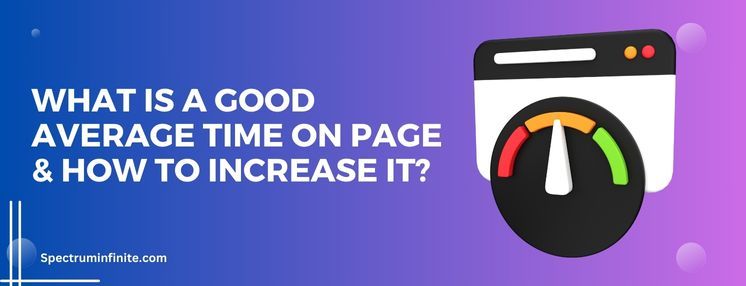Understanding Average Time Spent on a Website

Introduction: The Metric That Matters
The Average Time Spent on a Website is a crucial metric in the digital world. It reflects the total time users spend on a website during their visit and serves as an important parameter for gauging user experience and engagement levels.
Factors That Influence Average Time Spent
Many factors contribute to the time users spend on a website. These include but are not limited to:
- Website Design
- Content Quality
- Ease of Navigation
It’s crucial to evaluate these metrics for each specific page within a website.
Measuring Tools and Key Metrics

Google Analytics is an invaluable tool for understanding how to calculate the average time spent on a website. It provides detailed insights into metrics such as total time spent on site and average session duration.
Implications for Business
Tracking these numbers over time allows businesses to pinpoint pages or areas of their site that might need improvement. Important components like page views and load times also come into play.
The Impact of Page Views and Load Times
Page views refer to the number of times users have viewed each specific page during their visit. Load times indicate how quickly each web page displays its full content. A higher number of page views and shorter load times generally contribute to a well-optimized website.
Strategic Importance of Average Time Spent
Observing changes in the amount of time users spend on your website enables you to adapt your strategies for boosting engagement and retention rates more effectively.
How to Calculate Average Time Spent on a Website

Introduction: The Importance of Measuring Time
In the arena of digital analytics, understanding how to calculate the average time spent on a website is critical. It yields profound insights into user engagement and site effectiveness.
The Calculation Method
The method is straightforward. Google Analytics, a premier tool in this field, takes into account three essential factors:
- Total time users spend on your website
- Number of visitors
- Specific page views
The process involves dividing the total time spent by all users on your website over a certain period by the total number of visitors during that same period.
Consideration of Various User Types
This figure includes both people who bounce off almost immediately and those who linger for long durations.
Advanced Metrics: Beyond Overall Site Usage
Diving deeper into analytics allows you to measure not only overall site usage but also the ‘time on a page’ metric. This measurement helps identify which parts of your site are most engaging or require improvement.
Time on a Page and the Role of Load Times
The ‘time on a page’ is calculated by subtracting the timestamp of the initial view from that of the next view within a single session. It’s important to note that this does not include load times, which can skew the data negatively if they’re excessive.
Understanding Average Session Duration
‘Average session duration’ refers to how much time users spend during each visit or ‘session’ before leaving or getting timed out by Google Analytics after 30 minutes of inactivity.
Beyond the Numbers: The Broader Context
While these figures offer invaluable insights, they form only part of the broader picture. Website design, for instance, can significantly impact these metrics.
Additional Factors Influencing Time Spent
Intuitive and user-friendly design might increase average time spent, as users find it easier to navigate and locate relevant information.
Industry and Demographic Variances
The average time spent can vary greatly between industries and target demographics, so it’s essential to consider these metrics in your specific context.
Strategic Considerations for Optimal User Engagement
The ultimate goal is to consistently monitor and adapt your strategy, utilizing analytics tools, to provide an experience that resonates with your users.
What is a Good Average Time on Page & How to Increase it?

The Metric of Engagement
In the realm of digital analytics, a critical metric that often garners attention is the average time on page. This refers to an approximation of the duration for which a visitor lingers on a specific page.
Defining ‘Good’ in Average Time on Page
What constitutes a ‘good’ average time on page can vary significantly depending on factors such as the nature of your website and its content.
Examples Across Different Website Types
For instance, an in-depth research or educational website with long, richly detailed articles might see an average time on page exceeding five minutes as a sign of successful user engagement. Conversely, a retail site with concise product descriptions designed for quick browsing might consider an average time under two minutes to be favorable.
Strategies to Boost Average Time on Page
There is always room for improvement, and various tactics can be employed to increase this metric.
1. Elevate Your Website Design
Improving aspects like aesthetics, ease-of-navigation, and mobile-responsive design can have a direct impact on the time users spend on your web pages.
2. Minimize Load Times
Reducing load times is crucial in today’s fast-paced digital universe. Slow-loading websites can deter visitors from spending much time on your content.
3. Optimize Content Quality
Ensuring the relevance and quality of your content is paramount. Engaging material naturally encourages visitors to stay longer, thereby increasing the total time spent on your site.
Using Google Analytics for Insights
Google Analytics allows you to not only measure but also understand patterns concerning average time spent, which can be leveraged for future improvements.
Quality Over Quantity: The Final Word
While increasing page views is desirable, it should not come at the expense of quality or user experience. At the end of the day, what truly matters is not just the amount of time spent, but the quality of that time.
Found this information helpful? Write to us at team@spectruminfinite.com for more information.
Read this useful article for more insight :





